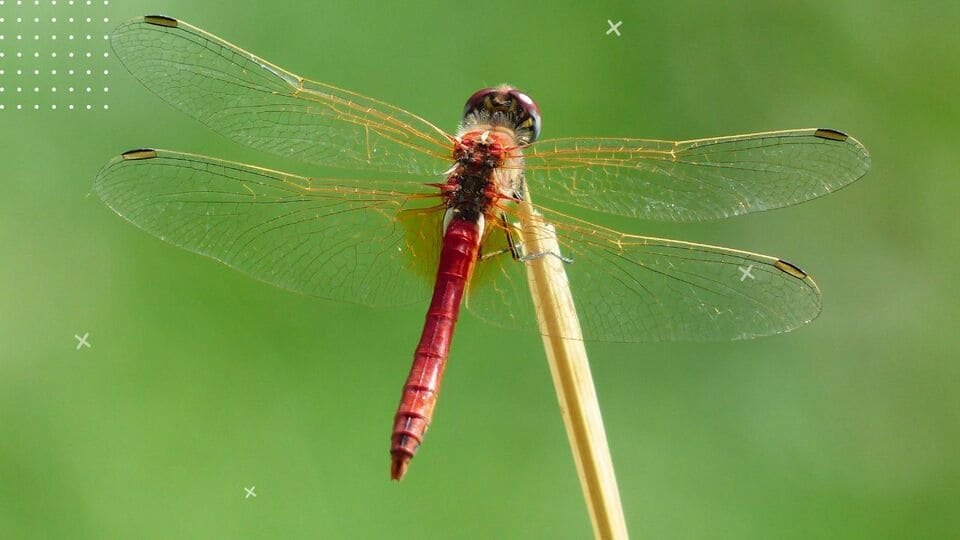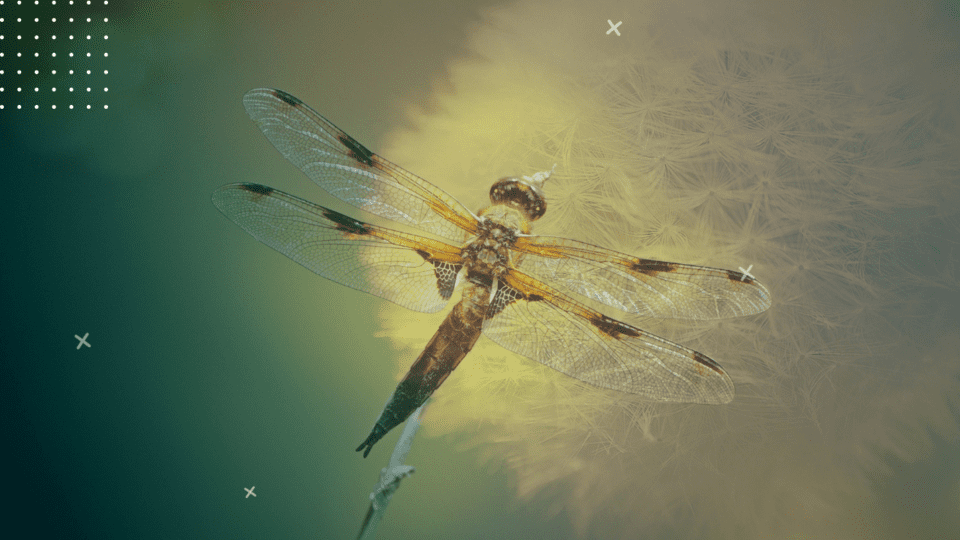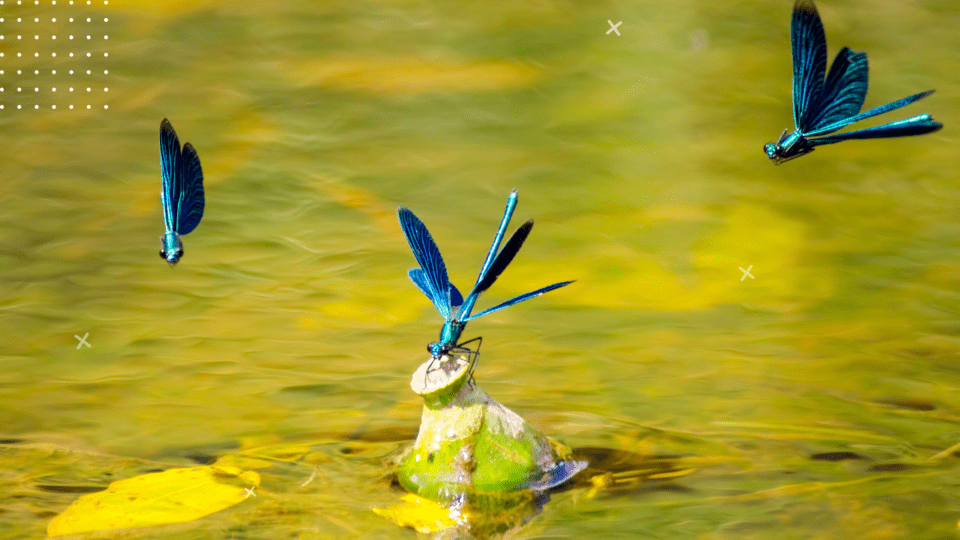


Darting dragonflies are a familiar summer sight around lakes and ponds. But did you know these acrobatic insects also contribute to pollination?
Pollinators like bees, butterflies and hummingbirds are well-known. Yet dragonflies also transport some pollen between flowers. They are not efficient specialized pollinators, but still facilitate incidental gene transfer between plants.
Certain flowers likely co-evolved with dragonflies as pollination partners. Let’s explore how they creatively tap into dragonfly flights to disperse pollen!
Dragonflies incidentally move pollen between blooms due to their:
During territorial skirmishes, mating pursuits, aggressive defense of breeding sites, shelter seeking and other behaviors, dragonflies casually alight on vegetation. Legs, wings and bodies inadvertently contact pollen grains.
These unintentional grain pickups brush off later across other site visits. While haphazard and irregular, some plants capitalize on such messy transmission.

Individual dragonflies distribute almost negligible amounts of pollen. However mass seasonal movements involving millions of migrating or swarming individuals likely achieve substantial cumulative pollen redistribution.
A few dragonfly species like globe skimmers (Pantala flavescens) complete incredible transcontinental migrations. As these weary long-haul fliers rest intermittently, they may leave pollen far from its origin. Such epic migrations likely spread plant genes across unfathomable distances no other insect couriers traverse.
A few specialized blossoms seem tailored to dragonfly flight habits and behaviors:
Brilliant red cardinal flower (Lobelia cardinalis) spikes blooming from July through September attract soaring dragonflies patrolling wet meadows and marshy areas. Their color, exposed orientation, sturdy landing platforms and abundance in prime dragonfly habitat suit these airborne wanderers.
While hummingbirds also appreciate cardinal nectar supplements, some research suggests dragonflies were the original specialized pollinators. Adaptations accommodating their particular body configuration and flight style reinforce this partnership over time.
Another summer-blooming aquatic plant – Pontederia cordata or pickerel weed – lures wandering dragonflies to stop by its violet-blue flower clusters. Abundant nectar entices refueling after lengthy dragonfly hunting forays over neighboring water bodies.
As they probe the blooms for sustenance, pickerel weed’s prominent stamens dust visiting dragonflies with sticky grains. The flower relies on these errant pollen couriers returning later to fertilize other distant plants.
Vivid pink swamp milkweed (Asclepias incarnata) inhabits marshy zones teeming with dragonflies. Like other specialized milkweeds, its complex blossom structure matches a dragonfly’s leg span perfectly. As they wander inside, movable pollen sacs attach to their limbs.
Later visits to different swamp milkweed patches results in pollen redistribution far exceeding what small local insect residents achieve. Dragonflies help this milkweed colonize isolated wet sites. Their far-flung hunger-driven hunting sorties spread genetic diversity broadly.
Seasonal activities involving huge dragonfly aggregations create peak pollen transport times:
Spring/Fall Migration Swarms – Mass relocations along flyway corridors likely achieve significant cumulative pollen spread. Exhausted migrants pause along the journey to refuel, depositing pollen grains picked up from earlier resting points.
Summer Breeding Congregations – Swarming, courtships, territorial fights, egg-laying etc. temporarily concentrate large local dragonfly populations. More activity and flower visitations get pollen circulating rapidly during these seasonal booms.
Beyond these short-term frenzied interactions, individual dragonflies contribute only minor sustaining, localized pollination among favored wetland plants. Their specialized adaptations for aerial hunting limit systematic flower visitations.

Dragonflies fall short of highly evolved specialist pollinators like bees for several reasons:
| Bee Advantages | Dragonfly Challenges |
|---|---|
| Ultra-fine hairy pollen baskets | Smooth, bare bodies |
| Nectar-sucking tubes access deepest flowers | Short chewing mouthparts only skim surface nectar |
| Actively gather and transport pollen | Passively Contact random pollen |
| Loyally focus efforts on single bloom types | Visit wide assortment of flowers inconsistently |
| Centralized and social lifestyles | Solo existence except brief seasonal encounters |
| 100+ million managed US honey bee hives | No stable or concentrated populations |
As beloved honeybees demonstrate, modern agriculture depends on highly efficient pollen transfer between specialized plant partners. Solitary generalist dragonflies can’t replace this tight co-evolution.
However, a few ancestral flowers still utilize these unorthodox couriers. And dragonflies likely acted as original pollination pioneers for some species before bees dominated this realm! Their contributions now supplement more famous pollen transfer experts.
While small compared to meticulous bee propagation, dragonfly pollination still matters. Their inadvertent blossom-to-blossom flights highlight the diversity underlying natural pollination networks.
We need to protect all pollinators – native bees, wasps, beetles, butterflies etc. These supporting ecological roles buffer against disease outbreaks, population declines or habitat disruptions threatening European honeybees.
Dragonflies pollinating plants for 300 million years reinforce that connections between multiple fliers, crawlers, hoppers and creatures keeps botanical worlds renewing. Consider thanking them next time one flies past! Even “nuisance” mosquito hawks contribute.
Do dragonflies pollinate flowers?
Yes, dragonflies do contribute to pollination, although they are not as efficient as bees or other specialized pollinators. As dragonflies feed on nectar or rest on plants, they inadvertently pick up and transport pollen grains on their wings, legs and bodies. Some flowers even seem adapted to take advantage of dragonfly pollination.
How do dragonflies help with pollination?
The main ways dragonflies facilitate pollination is through:
What flowers use dragonflies for pollination?
A few flowers are specialized for dragonfly pollination, like cardinal flower, pickerel weed and swamp milkweed. Their position, color, bloom period and other traits attract and accommodate visiting dragonflies. The co-evolution makes dragonflies effective secondary pollinators.
When are dragonflies most active as pollinators?
Dragonfly pollination is concentrated around spring/fall migrations and summer breeding seasons when huge numbers congregate. Outside these brief frenzied periods, individual dragonflies likely only distribute small amounts of pollen locally.
Why can’t dragonflies replace bee pollination?
While important ecologically, dragonflies lack specialized adaptations like hairy pollen baskets, social behavior and flower consistency of bees. As vital crops demonstrate, plants depend on very efficient, co-evolved pollinator mutualisms that solitary, generalist dragonflies can’t replicate. But their supplemental participation does matter.